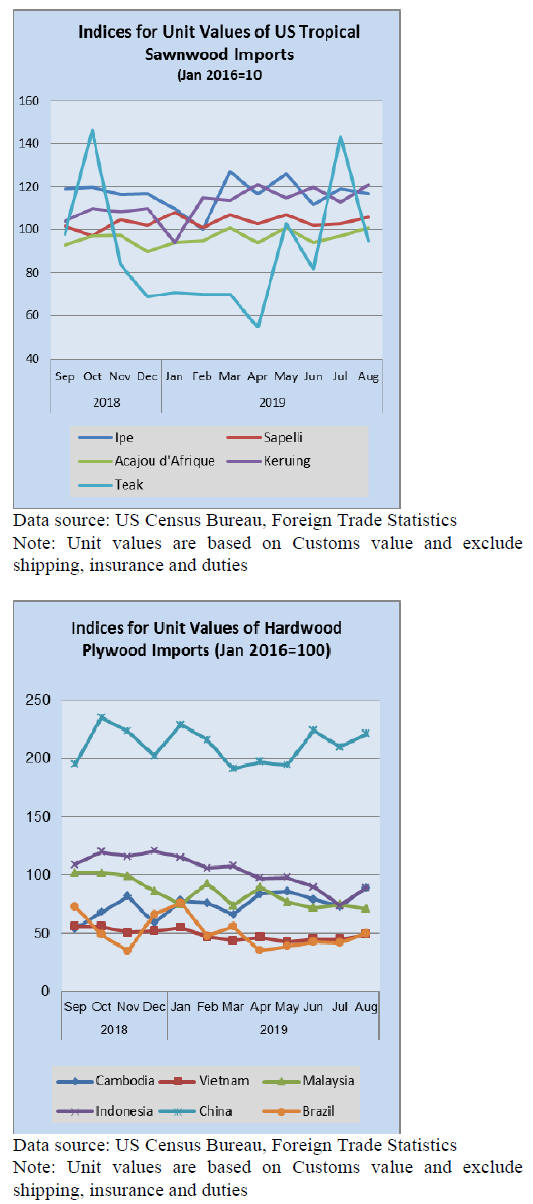|
Report from
North America
Largest hardwood mill closes as trade war impacts
industry
Tacoma, Washington-based Northwest Hardwoods will
close its Mount Vernon, Washington and Maury River,
Virginia mills in November, laying off 100 employees.
The largest US hardwood supplier said the decision was
made "as prospects dimmed for a quick resolution to the
US/China trade dispute".
According to the White House a ¡°phase one¡± agreement
with China has been reached. This halted a proposed
October tariff hike. Both sides are working toward a deal
for November¡¯s Asia-Pacific Economic Cooperation
summit in Chile. But any possible trade deal with China
now being negotiated might not be broad enough to save
US hardwood timber companies from layoffs, cutbacks
and closings, say analysts.
Chinese tariffs imposed on exports of red oak, walnut and
other hardwoods have cut almost 50% of the revenue in
the industry since 2017, according to the American
Hardwood Export Council.
Lumber companies have responded by closing sawmills
and eliminating shifts. Since the trade war with China
commenced, the value of exports of US hardwood lumber
dropped by almost 57% to US$54 million in August, from
US$124.8 million in August 2017, according to AHEC.
Housing starts decline in September, but indicators
suggest slowdown is temporary
Construction of new houses in the U.S. fell more than 9%
in September, but a recent surge in permits suggests the
decline in so-called housing starts is just a brief pause in a
real estate market recently reinvigorated by lower
mortgage rates. Housing starts slid to an annual rate of
1.26 million las month from a revised 1.39 million in
August, the government said Thursday.
The slowdown was concentrated in new buildings with
five units or more that typically get rented. Permits to
build new houses, meanwhile, fell about 3% to a 1.39
million annual pace. The number of permits filed was
nearly 8% higher compared to a year earlier, however.
Work on new houses slowed in all four regions, with the
Northeast and Midwest experiencing the biggest declines.
Construction of apartments, condominium complexes and
other projects with five units or more sank 28% in
September. That type of new construction can swing
sharply from month to month.
New construction on single-family homes rose slightly to
an annual rate of 918,000, marking the highest level since
the start of 2019. Single-family starts have risen for four
months in a row and are 2.8% higher compared to a year
ago.
Construction has perked up following a steep decline in
interest rates. A 30-year fixed mortgage, for example, has
tumbled to as low as 3.5% from more than 5% a year
earlier.
Industry observers believe builders still aren¡¯t producing
enough new houses to satisfy demand, however, and they
are unlikely to dramatically scale up construction in light
of fresh worries about the health of the U.S. economy.
That¡¯s keeping home prices higher than they otherwise
would be and effectively capping overall sales.
Existing-home sales in the U.S. receded in September
following two consecutive months of increases, according
to the National Association of Realtors. Total existinghome
sales declined 2.2% from August to a seasonally
adjusted annual rate of 5.38 million in September. Despite
the decline, overall sales are up 3.9% from a year ago
(5.18 million in September 2018).
Existing-home sales in September dropped in every region
compared to the month prior. Compared to last year,
September sales increased in three of the four major
regions, while neither growing nor declining in the
Midwest. Median home prices in every region increased
from one year ago.
US job growth continues to slow
U.S. job growth slowed a bit in September, with 136,000
new jobs added to the U.S. economy, compared to 168,000
(revised) positions created in August, according to the
latest jobs report from the U.S. Bureau of Labor Statistics.
The unemployment rate dropped to 3.5%. That¡¯s the
lowest rate of unemployed Americans recorded since
December 1969.However, the U.S. economy lost 2,000
factory jobs and 11,400 retail positions. This suggests that
the U.S. trade war with China is hurting industries that
depend on exports and imports.
US Manufacturers Report - new orders, production and
employment contracting
Economic activity in the manufacturing sector contracted
in September, and the overall economy grew for the 125th
consecutive month, say the nation¡¯s supply executives in
the latest Manufacturing Institute for Supply Management
(ISM) Report on Business.
The ISM¡¯s measure of the health of the U.S.
manufacturing industry fell for the sixth straight month, to
a level not seen since June 2009, the last month of the
Great Recession. Manufacturing employment, new orders,
and production all contracted in September. Wood
products manufacturers also reported contraction in all
three areas.
¡°Global trade remains the most significant issue, as
demonstrated by the contraction in new export orders that
began in July 2019. Overall, sentiment this month remains
cautious regarding near-term growth,¡± the ISM report said.

|